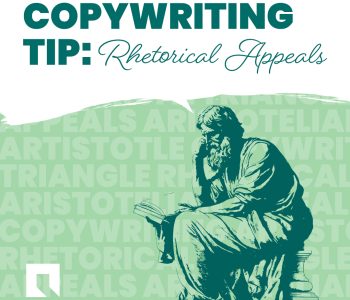
As marketing copywriters, we use persuasive rhetoric to encourage people to do something: change their way of thinking, compel them to take action, create an impactful story. Effective communication and persuasion rely on the strategic use of rhetorical appeals to engage and compel audiences. Whether crafting a press release, website content, or a social media post, the most successful persuasive writing is achieved when writers establish credibility, build a connection with the audience, and inspire that audience to take action.
What Are Rhetorical Appeals?
Rhetorical appeals are the framework around which we craft persuasive claims. Identified by the philosopher Aristotle in the 4th century BCE (and still relevant today!), the three rhetorical appeals are ethos (establish trust), pathos (evoke emotions), and logos (appeal to logic).
Pictured here, the Aristotelian Triangle – also known as the Rhetorical Triangle – provides a visual of how each of the three elements rely on each other to create a compelling persuasive claim or argument.
Ethos (ethics) establishes the credibility and authority that is necessary to gain the audience’s trust. Credibility on its own may not be sufficient, which is why appealing to pathos (empathy, sympathy) – the emotions of your audience – plays an important role in engaging them on a deeper level and inspiring action (take care not to overdo your pathos, though; otherwise, your audience may feel manipulated). Without the support of logic and reason to balance out the emotion, you run the risk of being overly sentimental. This is where logos (logic) works its magic by solidly grounding your claim with a rational framework to substantiate your persuasive claim: facts, evidence, statistics, and so forth. It’s also possible to go overboard with too much factual evidence, in which case it’s effective to sprinkle in some emotion, too.
Rather than working independently, each of the three rhetorical appeals are interdependent upon each other to create effective claims.
Rhetorical Appeals in Marketing Copywriting
What do copywriters and an ancient philosopher have in common? A lot, as it turns out. We achieve this by using the same structure as Aristotle to craft compelling arguments that connect with our audience.
A contemporary version of the rhetorical triangle looks something like this:
A writer establishes trust and speaks to logic by using persuasive strategies like word choice, tone of voice, and evidence including facts, statistics, and research from experts in the field. When writing content about the stock market, for example, it’s more effective to incorporate quotations from a credible financial source than from a random meme on the internet. You know who the experts are and why they’re important. By speaking to the values and emotions of your targeted audience, you show that you’re invested in what’s important to them.
A very well known example of marketing that incorporates all three rhetorical appeals is the “Dawn Saves Wildlife” dish soap campaign. One commercial focuses on an animal rescuer gently bathing a cute duckling in a sink while a voice-over provides credibility and logic about why Dawn is both safe, gentle, and effective.
What Would Aristotle Say?
Aristotle would be thrilled that we’re still using rhetorical appeals to create compelling persuasive claims. It’s the same approach he used but with different modes, or, papyrus instead computers.
In our digital age, persuasive writing relies more than ever on credible data-driven arguments, appeals to an audience’s system of values and beliefs, and logical reasoning – all of which align with Aristotle’s emphasis on persuasion. When we balance ethos, pathos, and logos, copywriters can effectively engage and persuade audiences across platforms.

